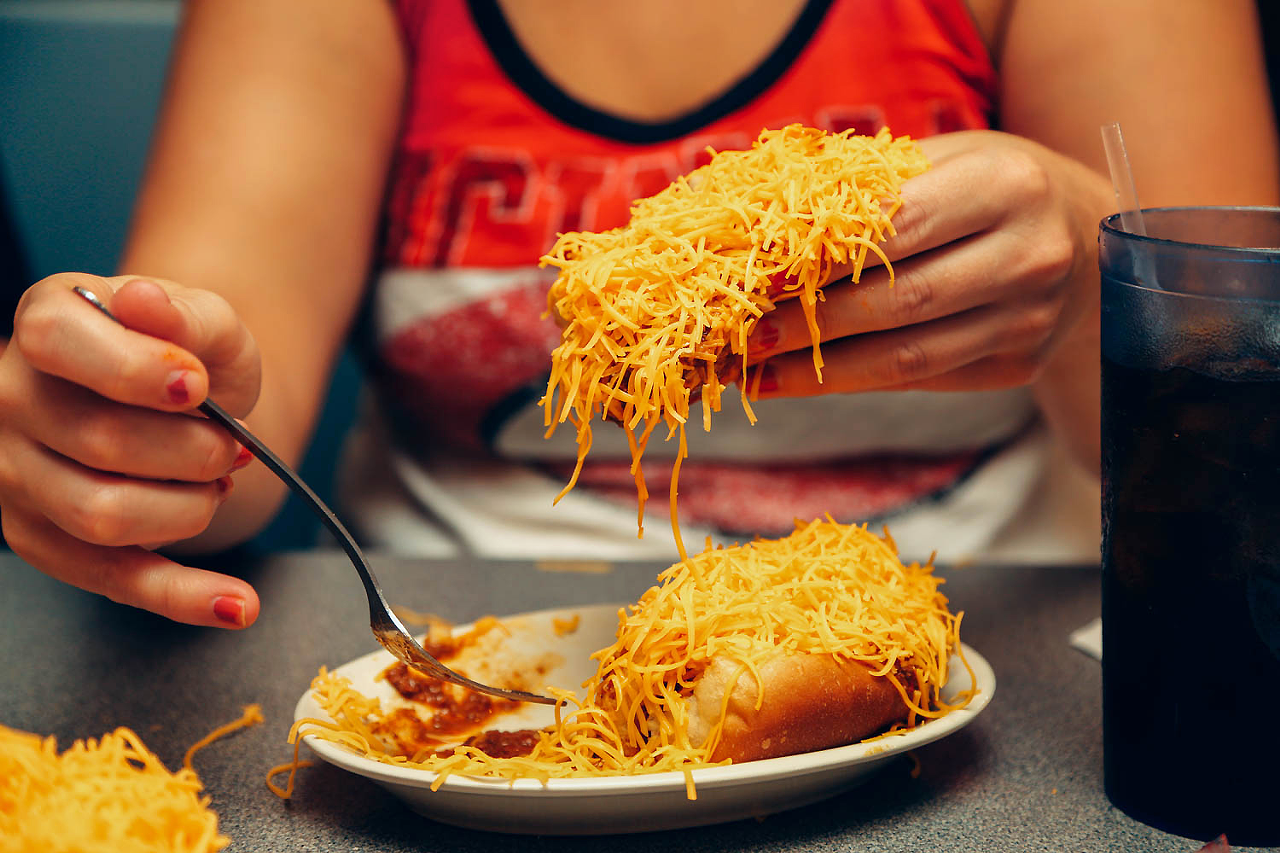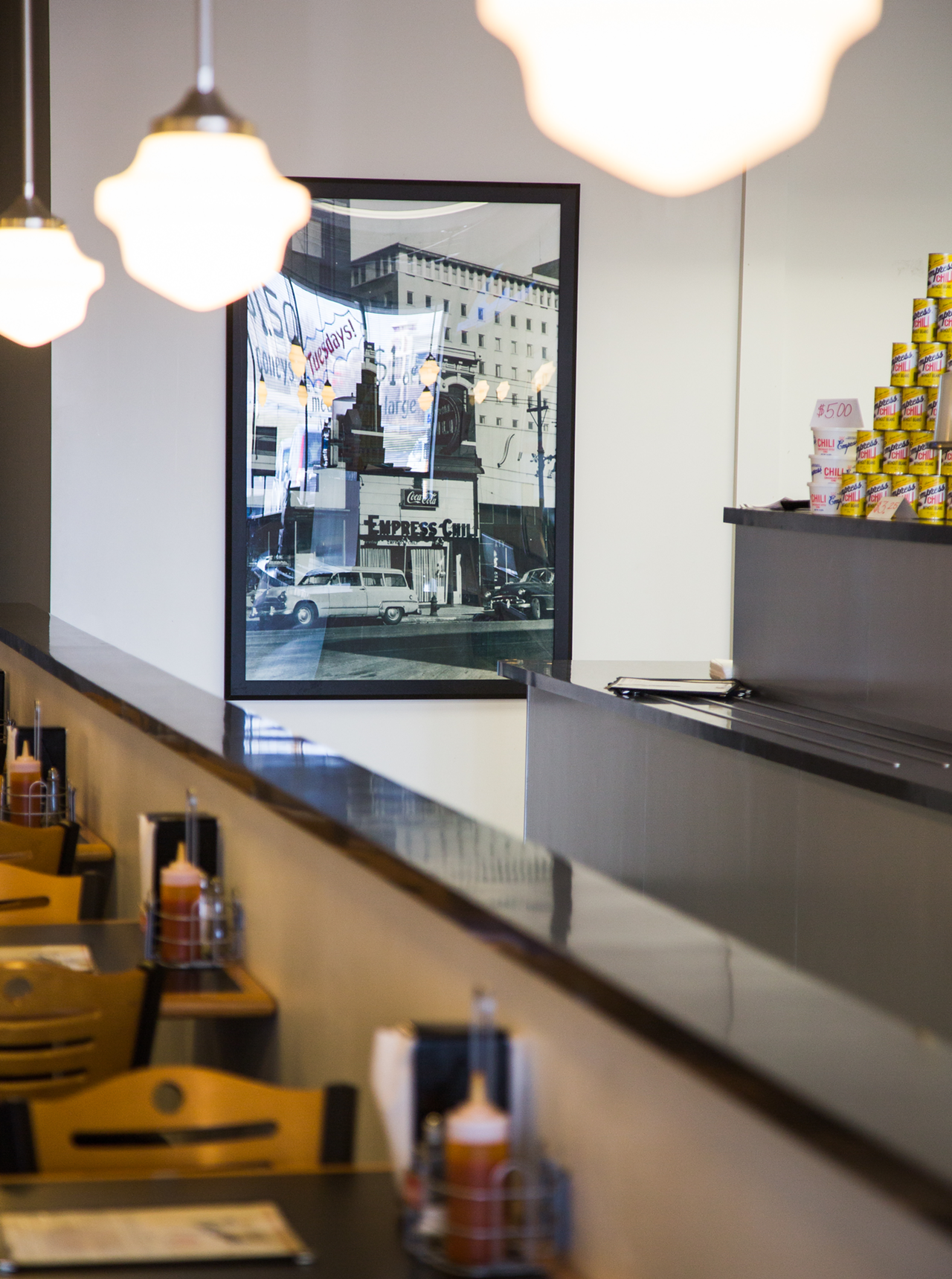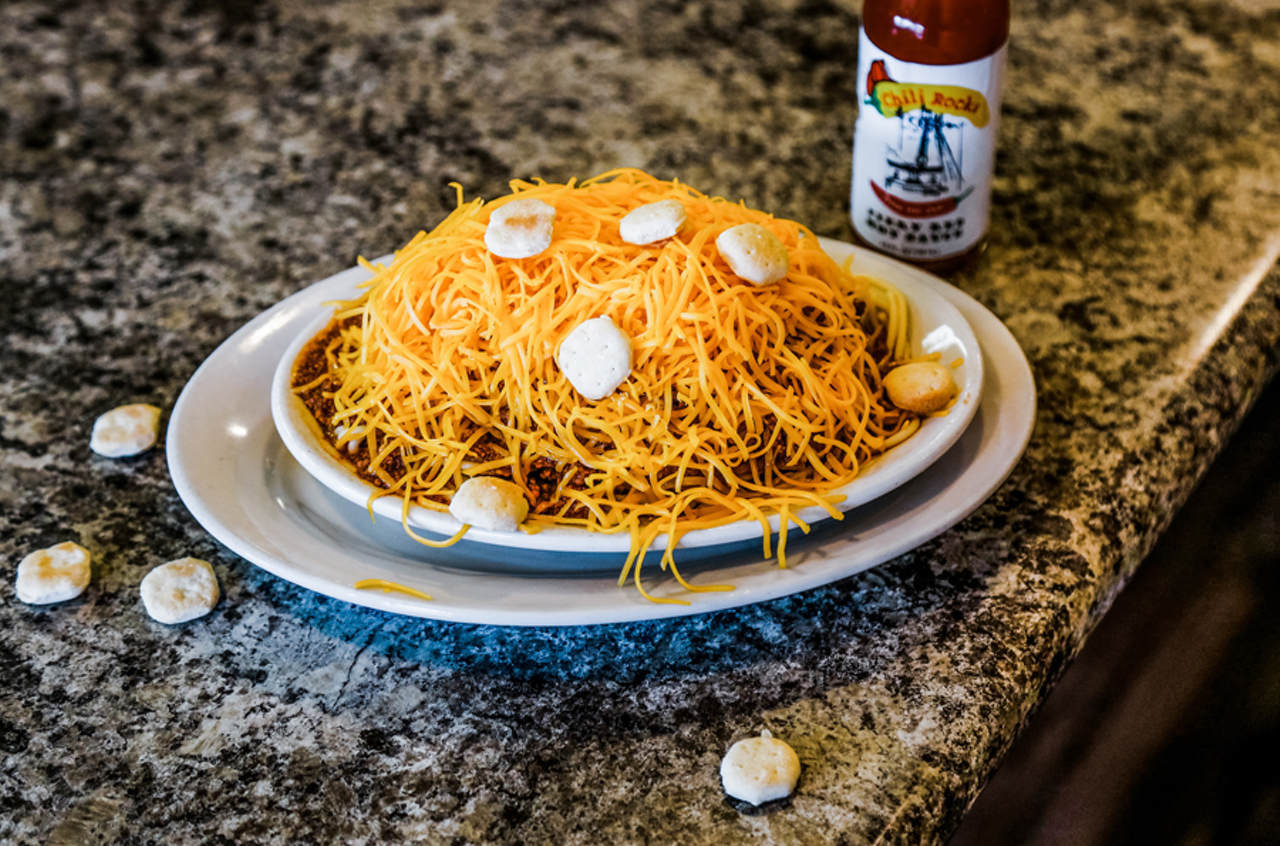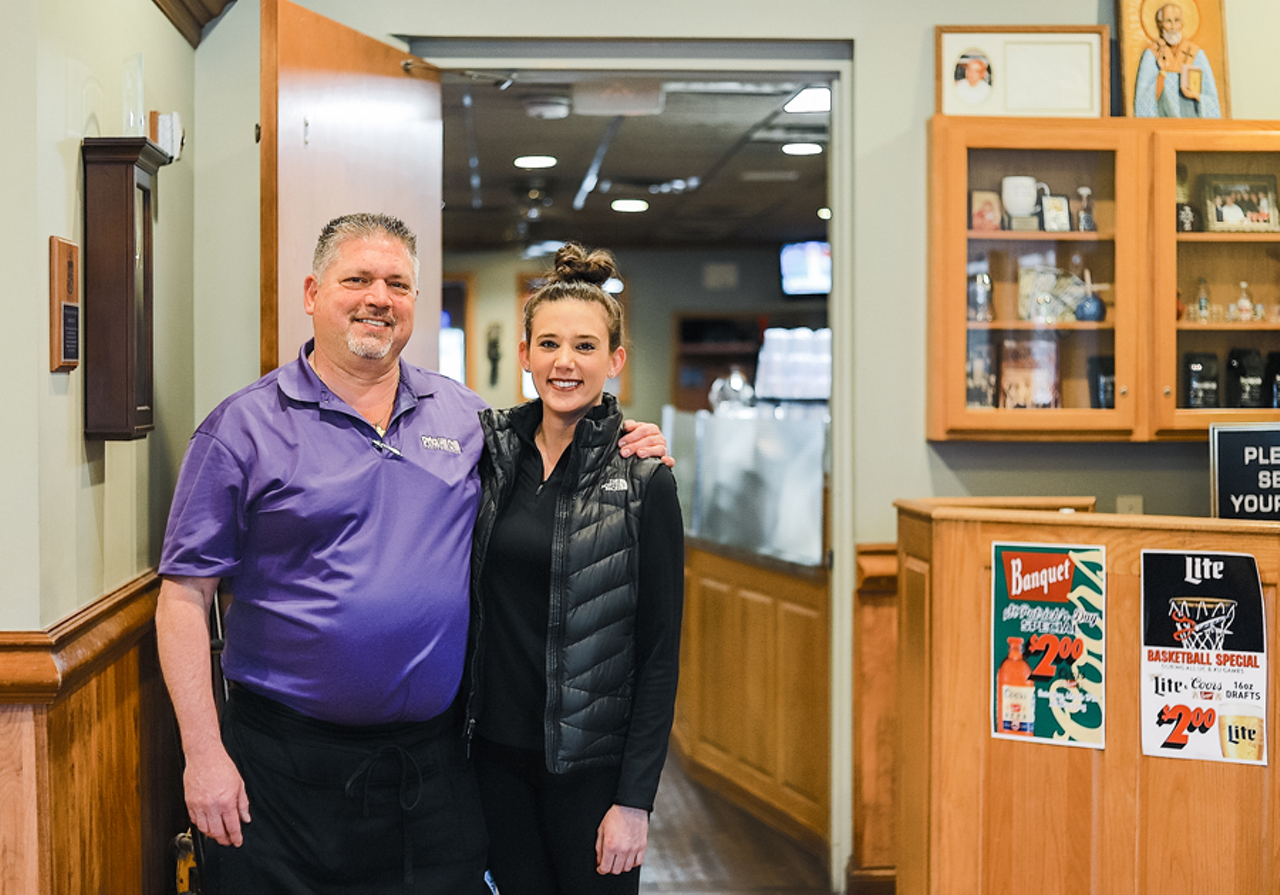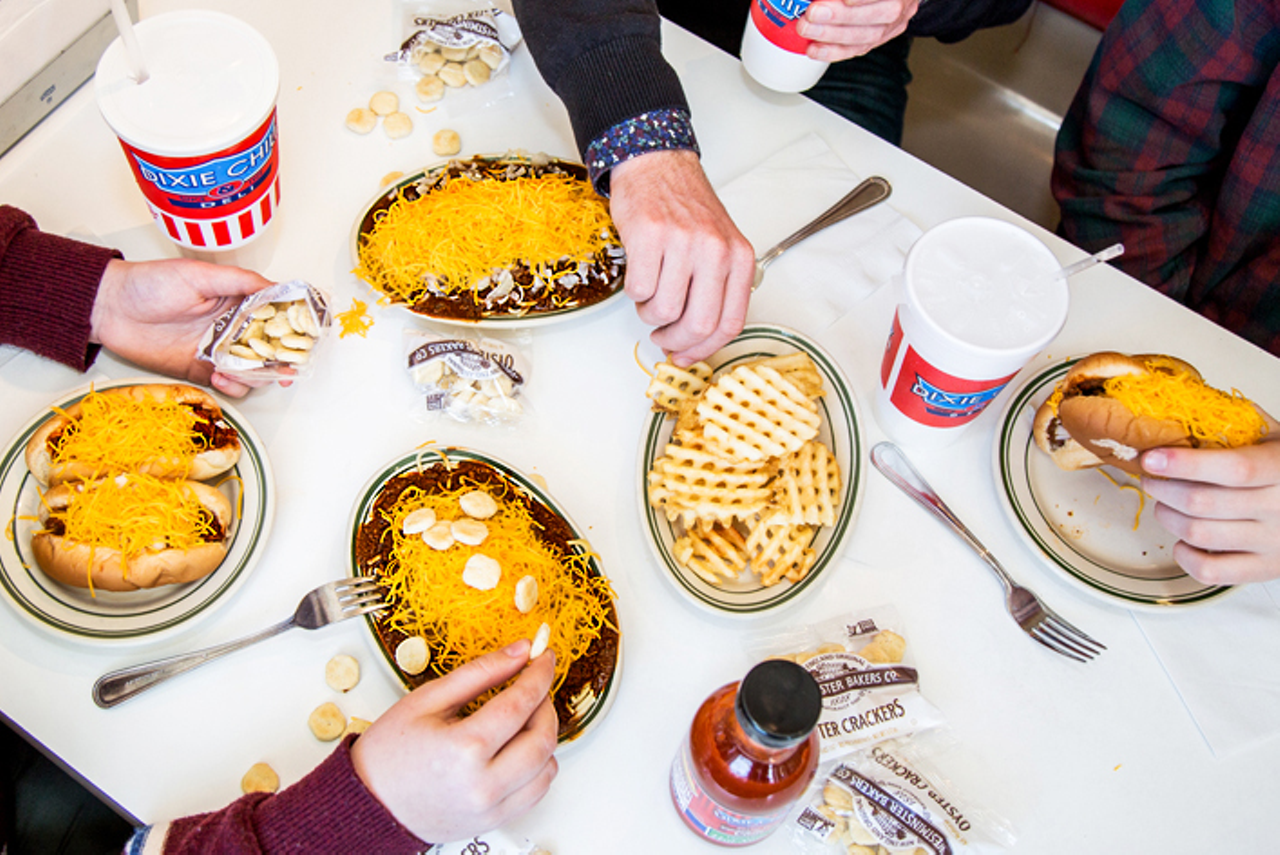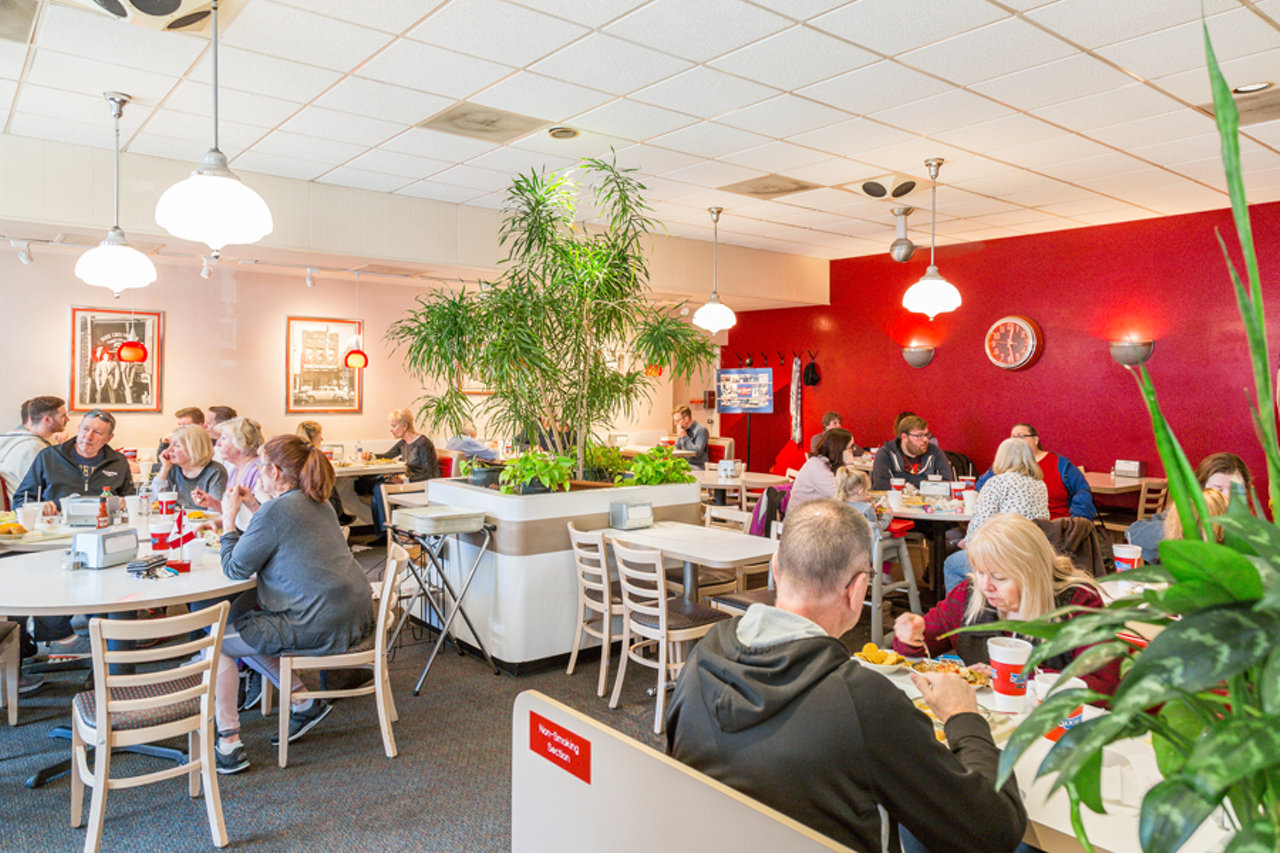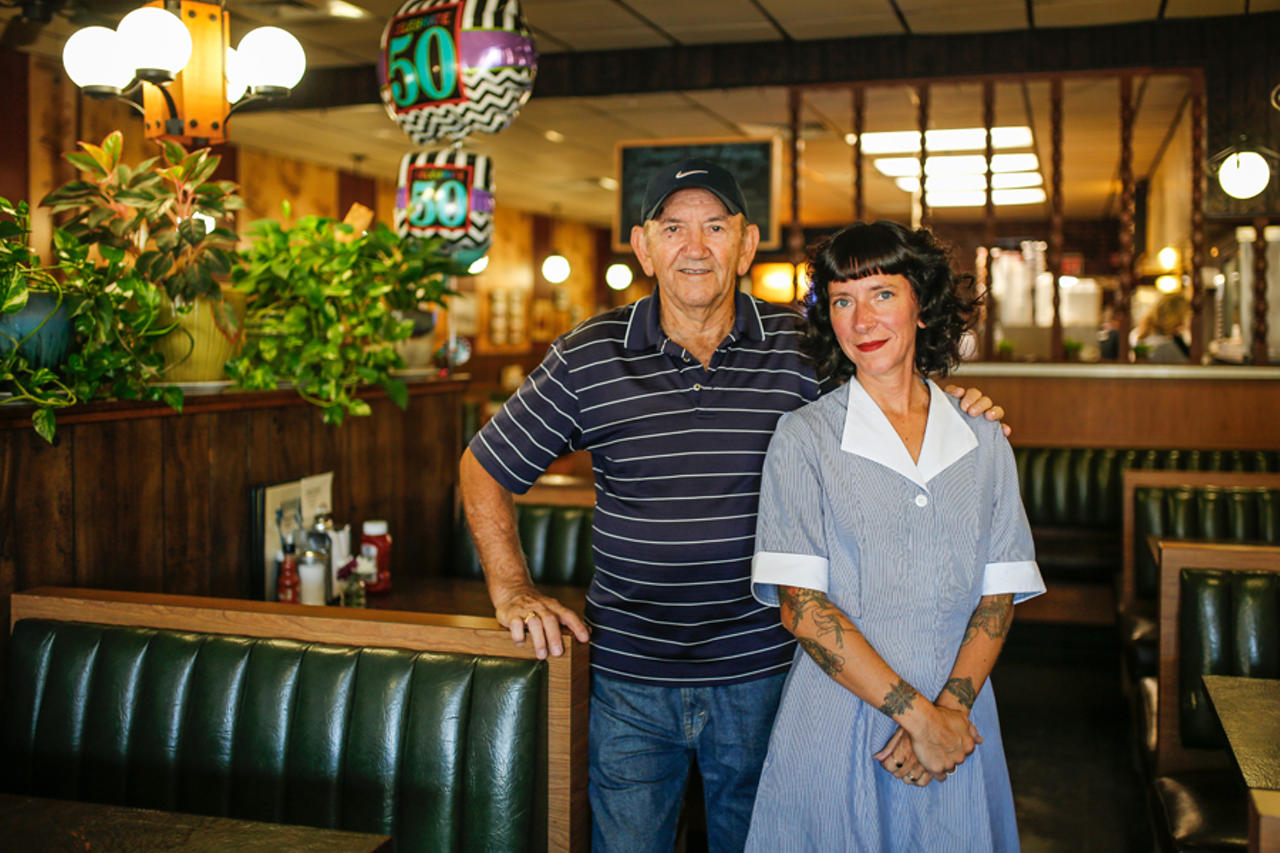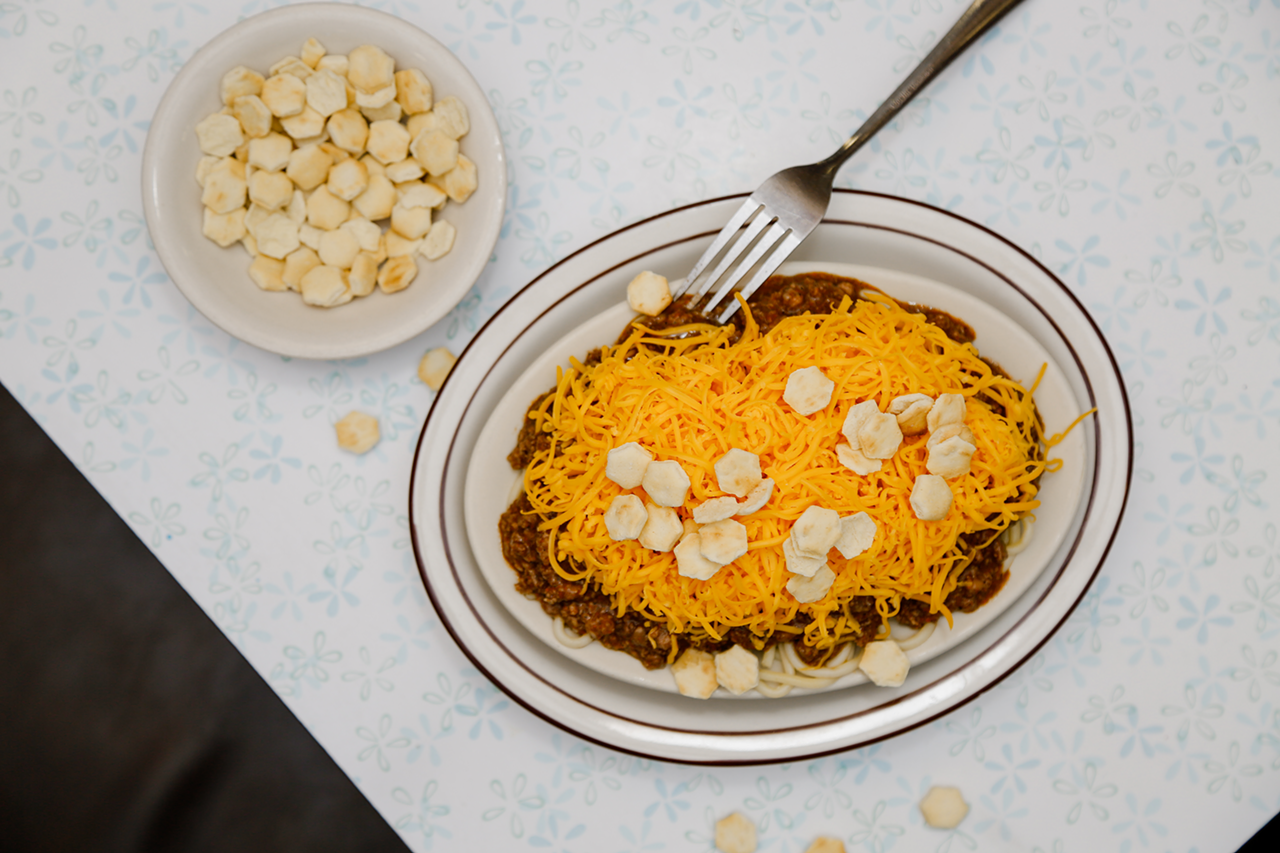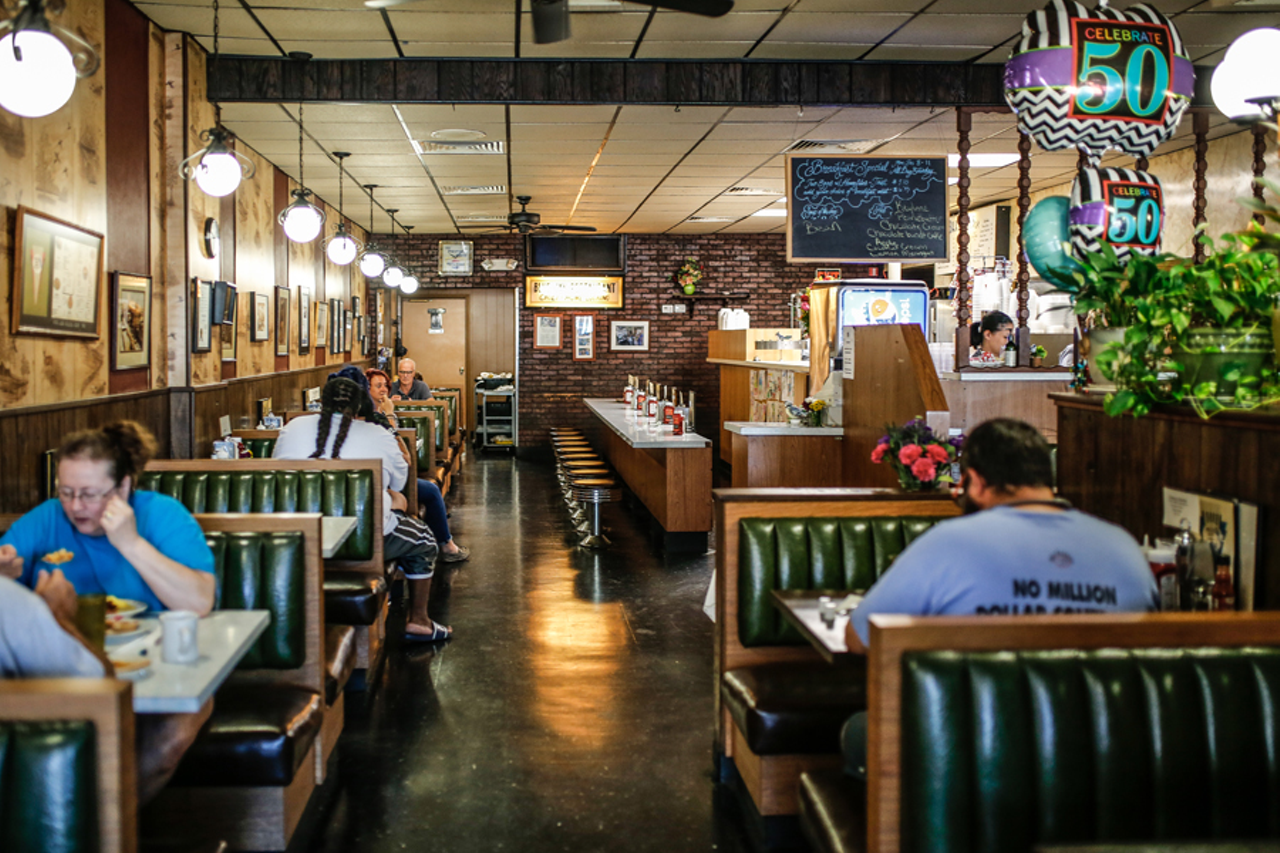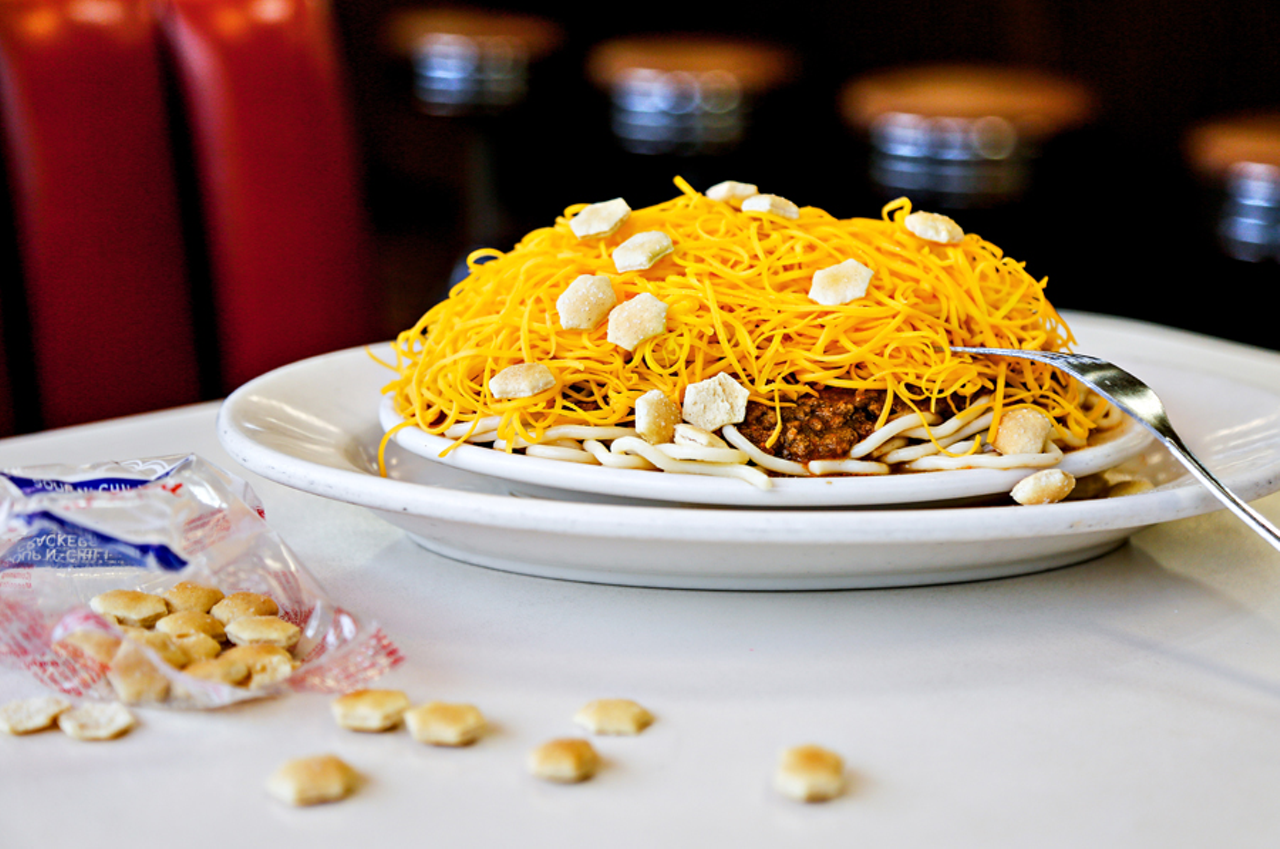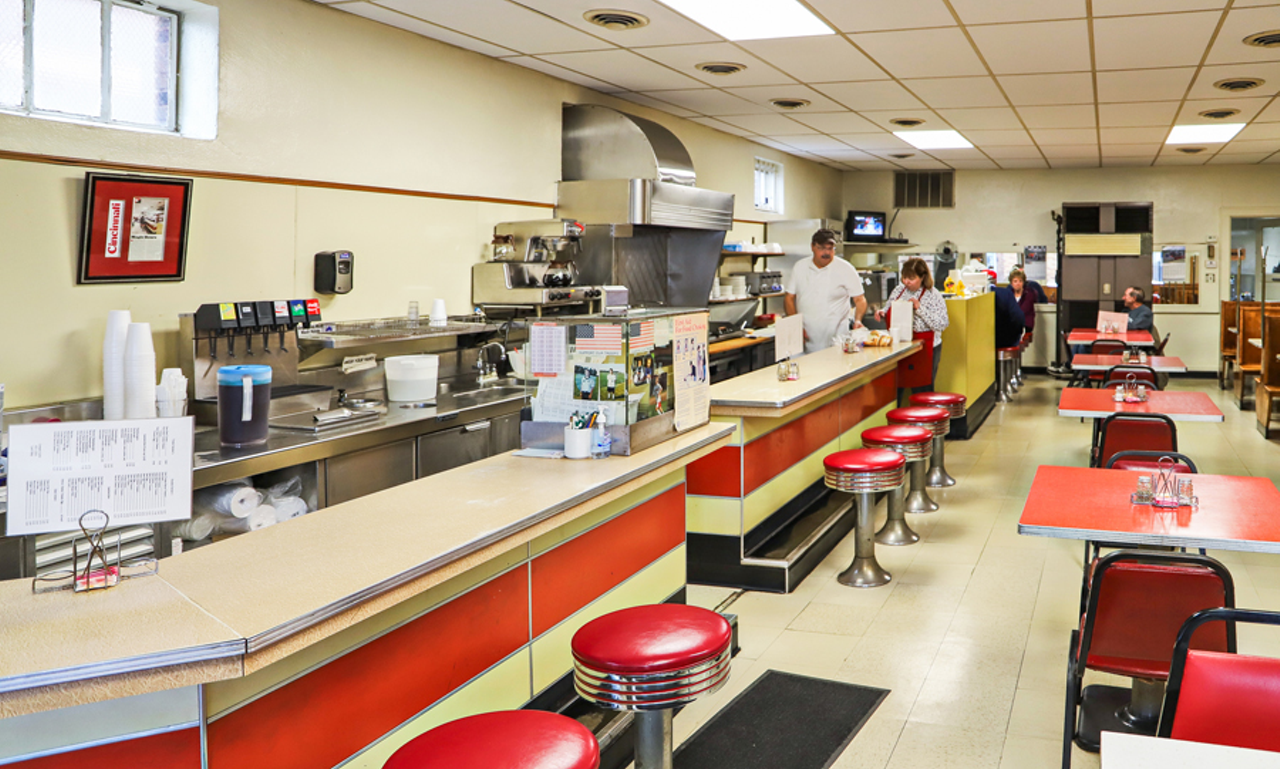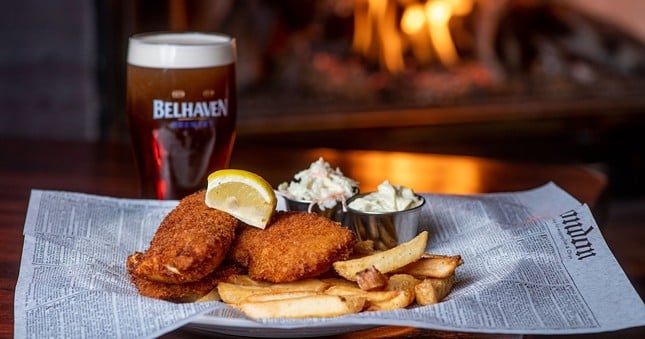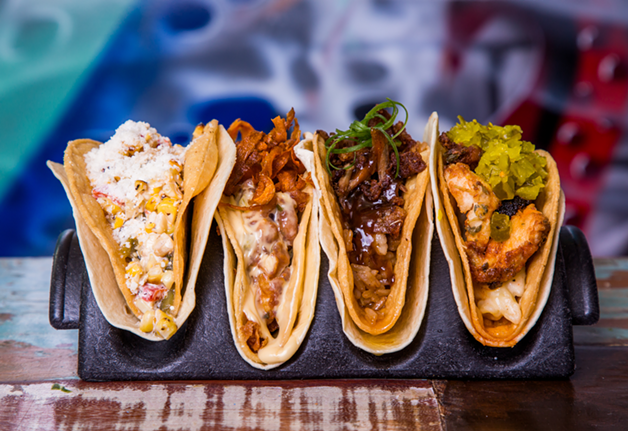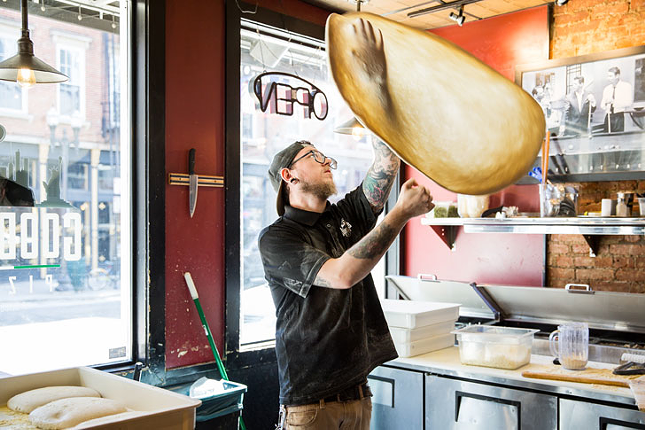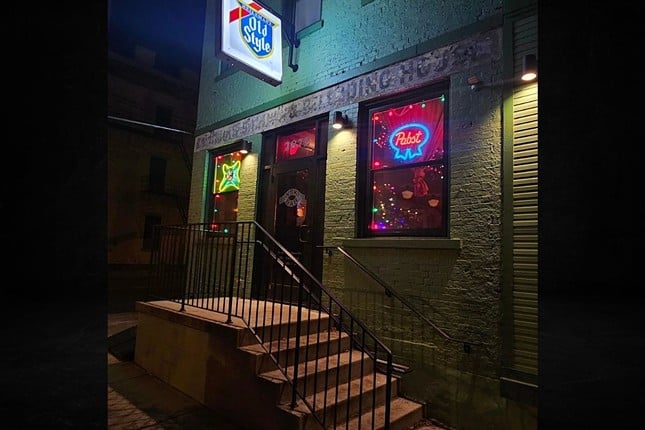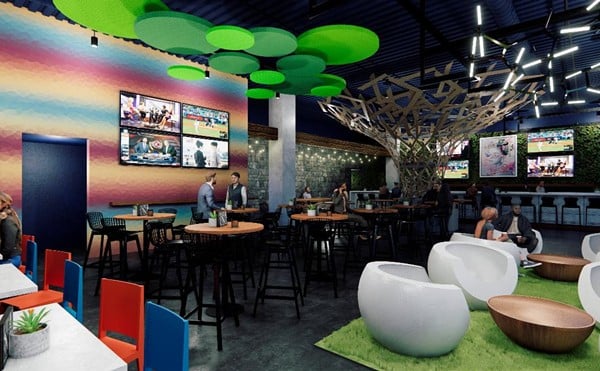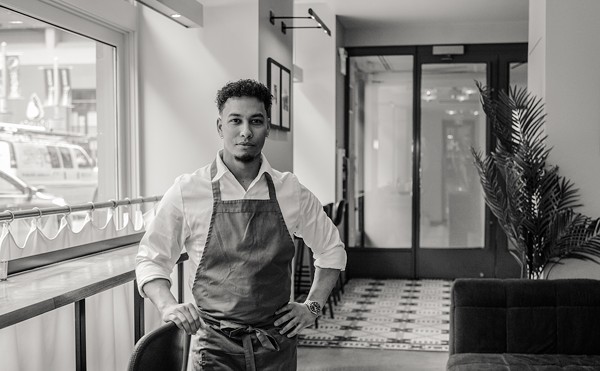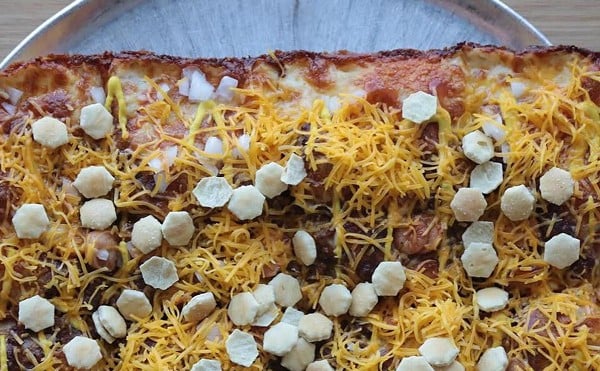If you’ve lived in Cincinnati for any amount of time, you’ve likely stumbled into the center of a debate between die-hard fans of Skyline and Gold Star: which local chili chain is the best? Both founded by immigrants — Skyline in 1949 by Greek transplant Nicholas Lambrinides and Gold Star in 1965 by the four Jordanian Daoud brothers — they used secret family recipes to create the city’s top feuding chili empires, spreading saucy meat and golden cheese across the Tristate.
But if partisan chili politics isn’t your thing, you can always take the road less traveled and try your tastebuds at a neighborhood parlor, which are just as steeped in tradition and their own unique recipes. Some, like iconic (and James Beard Award-winning) Camp Washington Chili or Food Network-featured Blue Ash Chili are already famous in their own right. Others? Others are more obscure and may not haven’t gotten the Guy Fieri stamp of approval, but are just as vital — and delicious — community institutions.
Starting with the godfather of chili parlors, Empress Chili, and working our way around the city from Northside to Newport, we tried to get a taste for the history and cuisine of several distinct neighborhood spots. We not only discovered the impact that Empress has had as the proverbial trunk of the local family tree of chili joints, but also that noodles slathered in meat sauce taste distinct at each destination.
We couldn’t visit every cherished chili parlor, but here are the fables and flavors behind those we did.
Empress Chili
3670 Werk Road, Bridgetown, empress-chili.com
The History: The first splattering of Cincinnati chili can be traced back to two brothers: Tom and John Kiradjieff, immigrants from Argos, Orestiko, a town in the now-Northwestern region of Macedonia-Greece. One brother immigrated to Cincinnati and then brought the other over in 1921.
A year later, they served the first bowl of Cincinnati chili.
James Papakirk, a first-generation immigrant from Greece, now owns the brand. He says that when the modest parlor first opened, it was a combination restaurant and dry goods store in the old Empress Burlesque Theatre storefront.
Like many of the parlors that followed, it thrived on community. Other immigrants came to work for the Kiradjieffs, and they helped one another settle in a new country. Later, several would go on to stake a claim with their own storefronts.
“I think it was a true phenomenon. I think it was a combination of a great dish, but a legacy of how those chili parlors operated,” Papakirk says of the chili chain reaction.
The lasting impact of Empress would exceed the “wildest expectations” of its founders in terms of what the staple dish has become, Papakirk says. (And, yes, the recipe is unchanged).
“The ongoing joke is that they can’t really find chili in Greece,” he says, adding that if you go up to a counter and ask, they’d refer to it as spaghetti with meat sauce. His theory is that the dish stems from a Greek-style lasagna called pastichio: thick, tubular noodles layered in a similar meat sauce with a thick layer of béchamel and spices reminiscent of Cincy chili. “(Empress’ Chili) has stayed more true to the old-world spice profile,” Papakirk says.
Talk to owners of parlors and diners who now serve up the dish themselves and many acknowledge their roots in Empress. Even Papakirk’s wife, Maria, is in on the legacy: her family founded Camp Washington Chili.
The Chili: In addition to the usual crop of double-decker sandwiches and ways, Empress offers some zany takes on old favorites: individual chili pizzas with cheesy, saucy fare on dough and the tough-to-pronounce “spagoney,” which swaps out hot dogs for noodles.
Feeling a little adventurous, I ordered a spagoney and a 4-way with beans. This was the first 4-way I’ve had that comes in a circular bowl, not a boat.
The consistency of the chili is smoother here than in other parlors. It’s paste-like, poured over big, pillowy noodles and topped with flossy cheese. It comes to your plate warm and goes down easily, tinged with a bittersweet aftertaste that is reminiscent of cocoa powder. It certainly substantiates rumors that parlors put chocolate in their chili, but the culture of secrecy surrounding these restaurants does not allow me to confirm or deny that.
The 4-way is definitely worth revisiting, but the spagoney works best as a novelty item. Mustard and pasta just don’t mix. Based on the rest of my observations, though, I can infer that the coneys are very good.
Price Hill Chili
4290 Glenway Ave., Price Hill, pricehillchili.com
The History: Regulars congregate around a no-frills bar in Price Hill Chili’s Golden Fleece Lounge, which the West Side staple added to the existing restaurant in the 1970s. In the center of it all sits a laughing Steve Beltsos, the owner of the family-run diner. His daughter is there, too, but an outsider wouldn’t be able to distinguish between family and customer — Beltsos treats everyone with the same warmth.
Price Hill Chili was founded in 1962 by Beltsos’ dad, Sam (though retired, he still comes to visit). Back then, the location consisted of one room that seated 50 people. Its menu and physical size have expanded since (it seats 350 these days), but the family values and wood-panelled aesthetics haven’t changed.
“We have generations of families,” Beltsos says. “I know the fathers, their kids and now they’re married, so now their kids. I’ve been here since I was basically 10 years old.”
Like many immigrants who opened chili parlors, Beltsos’ mom and dad are from a small village in Northern Greece named Kastoria (it’s now gone, bombed out of existence in World War II). Beltsos’ great-great uncle worked at Empress Chili,before he then spun off another restaurant called Latonia Chili. His father, Sam, worked there briefly before leaving his apprenticeship to open Price Hill Chili at age 22.
“He put in a lot and I put in a lot,” Beltsos says. “You have to be here. You have to watch; people want to see you. It’s the personal touch.”
Beltsos primarily knows people by what they eat, and tries to know everyone by name. The staff can time when Sunday masses in the neighborhood let out, as Catholics migrate from church pews to restaurant booths.
For many locals, Price Hill Chili is a slice of their own history. News clippings line the wall, including a photo of Beltsos’ daughter handing a coney to then-Vice President Dick Cheney.
“It’s my neighborhood, and I’ll look after it,” he says.
The Chili: Price Hill Chili’s 5-way, shaped like an Olympic stadium topped with a dairy dome, boasts a firmness its peers lack. The noodles are taut and hearty, without sacrificing their wobble — you actually taste them through the chili’s meatiness.
This is one of the more mellow iterations of the standard Cincinnati chili recipe, foregoing some spice for a warm sweetness. I find myself more focused on Price Hill’s texture than its taste: it’s somewhat oatmeal-y, while competitors opt for a more slurpable consistency. The 5-way fills me up fast, but doesn’t manage to topple my insatiable chili appetite. I drop a few Westminster Bakers Co. oyster crackers into the dregs of the dish, finishing it off.
Despite issues with structural integrity (it unraveled a bit en route to my mouth), Price Hill’s coney is still good. Stabbing at its remains with a fork, I spear a good blend of bun, dog and cheese. The frank is one of the better chili parlor offerings: it has that nostalgic, oily taste that reminds me of the uniformly beefy hot dogs you can only seem to get at sporting events.
The verdict: Price Hill’s chili is the comfiest in the city. It’s filling, warm and tastes like home, whether or not your family routinely serves up 3-ways and coneys.
Dixie Chili
733 Monmouth St., Newport, Ky., dixiechili.com
The History: In 1918, Greek refugee Nicholas Sarakatsannis arrived in the U.S. at age 15. Eleven years later, he turned a humble hot dog stand and knowledge gained working at Empress Chili into Northern Kentucky’s own take on Cincinnati Chili: Dixie Chili. Today, 150 gallons are still prepared in the Newport commissary — including a vegetarian version made with soy protein and Dixie Chili’s secret spices.
As recounted on the Dixie Chili website, Sarakatsannis walked into Empress, said he was looking for work, and they told him to slip on an apron. A year later, he opened his own parlor, which has flourished since.
Sarakatsannis’ youngest of six sons, Spiros, grew up in the chili business. His memories of working alongside his father stretch way back, and he says he still recognizes regulars. Now, he’s taken over the family business.
With a location in Newport, another in Covington and one in Erlanger, Dixie has become an integral part of Northern Kentucky culture; each location a local landmark in its own right.
The Chili: The cheese is transportive. Though I’ll have visited a good portion of the Greater Cincinnati area’s parlors by this trail’s end, Dixie is still my chili joint.
Just a block from my childhood home, the Erlanger Dixie Chili’s drive-thru was a regular stop for my grade-school self. I remember riding in the back seat of my grandmother’s car, a Styrofoam box of cheese coneys buckled into my lap — still warm. I’d pop the lid when I got home, letting the smell of fluorescent-yellow cheddar waft through the living room. My boyhood nostalgia is paved in chili.
Dixie’s flagship Newport location is more attuned to its urban surroundings than the neighborhood counterpart I’m used to. The checkered tile floors, cafeteria trays and ferns are still present, but they’re bathed in red neon.
I decided to upgrade from my usual 5-way to Dixie’s exclusive 6-way, which includes beans, onions and chunks of garlic, bursting with a slight sourness that adds an odd kick to the dish. Traditionally, Dixie’s offerings are dominated by their Wisconsin cheddar: so satisfyingly rich that I’m tempted to decapitate the way’s cheese toupee and snack on it separately. The liberal smattering of garlic acts as an effective counterbalance to the dairy, but it’s not quite enough to convert me from my 5-way.
Blue Jay Restaurant
4154 Hamilton Ave., Northside, 513-541-0847, searchable on Facebook
The History: Danny Petropoulos, though technically retired, still comes in nearly every day to Blue Jay Restaurant, which he opened with his late wife, Tina, 50 years ago. He takes pride in the soups and chili that populate the classic menu, and makes it all from scratch every day, sometimes at his house.
“My recipe is my own recipe. That’s it. Good recipe, people like it, I’ll stick with it,” Petropoulos says. “Sooner or later (my daughter) is going to do it, but as long as I’m healthy, I’ll do that.”
The origins of that recipe can be traced back to a small Greek village, Variko, where Petropoulos grew up and where his father had a restaurant of his own. In 1951, his wife immigrated and settled in Cincinnati. She came back to the village, they got married and he joined her in the Queen City in 1959.
After working at his uncle’s now-closed chili parlor and a stint at MacGregor’s Sporting Goods making golf clubs, he opened the restaurant that would become a Northside staple. Not much has changed since. The deep green vinyl and distinctly ’60s wallpaper with dark wood panels speak of legacy, tradition and generations of hearty meals and hearty laughter.
Beyond chili, many flock to the diner for nostalgic breakfasts and classic lunch fare. Petropoulos’ daughter, Souli, who took over the business, doubled up the menu. The original iteration hangs just above the grill, and was used in the upcoming Robert Redford flick, Old Man and the Gun.
Petropoulos says his wife Tina, who passed away mid-February, worked harder and taught him more about life (and cooking) than anyone he knows. With their daughter at the helm, the tradition continues. “If you go today, you won’t find a seat to sit down. Specials all day. It’s booming,” he says.
And he’s right: Walk into Blue Jay on a weekend morning and there’s hardly a seat to spare.
The Chili: While other chilis strive for a blend of saucy and hearty that leans toward wetness, Blue Jay embraces the natural mouthfeel of ground beef. It’s akin to a taco salad, if your idea of a salad eschews leafy greens for cooked pasta. Among an extensive line-up of classic diner fare that could complement your order, I appreciate that Blue Jay’s ways go easy on the grease.
The dish is filling, but not so much so that you can’t leave room for a side of crinkle-cut fries, which are reason enough to make a Northside pit stop. If you prefer your chili with a side of conversation, this is probably the most interesting place to do it. The diner’s always bustling, and the walls are covered in woodland-themed artwork that sets an oddly rustic tone for your lunch with friends.
Chili Time
4727 Vine St., Saint Bernard, chilitime.net
The History: Along Saint Bernard’s main drag, one sign stands out — a cartoon clock suspended in half a cup of chili. The message is clear: it’s chili time.
The orange awning is vibrant among unassuming small-town storefronts and the interior is just what you’d expect from a no-frills establishment; one at which Gary Stidham has worked at for 40 years. Starting as a dishwasher, he worked his way up to manager.
He points to a building across the street with wooden shingles: Chili Time’s original location from 1963 until they moved in 1986. The original owners, brothers Harry and Pete Vidas, worked at Empress downtown before concocting their own recipe, which the family still owns. Harry’s son, Chris, now owns the restaurant with his wife, Kim.
“This town has changed a lot in its time. At one time, Procter & Gamble was a big company (in Saint Bernard). A lot of people worked there. It left, so it’s changed. It went from a city to an actual village,” Stidham says. “We still get a good crowd here. We still get a lot of people who’ve left Saint Bernard, and they want to come back here and eat at Chili Time.”
“I probably eat a cheese coney everyday,” he says.
The Chili: I’d heard from fellow CityBeat staff that Chili Time’s titular dish had a “floral” taste: a sensation I wasn’t able to imagine until actually digging into a plate. I couldn’t come up with a more accurate way to describe my 4-way’s herby, salty flavor, which tasted a little different with each bite — some forkfuls are as savory as Skyline’s fare, while others are uniquely sour or earthy.
Whether you order a way or a coney, it’ll come buried in a heap of soft, crumbly cheddar you could mistake for goat cheese were it not so yellow. I wouldn’t mind eating a full bowl of it on its own, if I respected my body a little less.
At this point in the trail, I was so inundated with chili that I decided to forego it on my coney, opting to top mine with just cheese, mustard and the bottle of Frank’s RedHot sauce sitting at the table. Thanks to the cheese, this wiener was a winner, even without a key ingredient.
Cretan’s Chili Restaurant
7039 Vine St., Carthage, 513-821-1203
The History: Well-hidden in Carthage, Cretan’s Chili Restaurant is a vintage oasis that doesn’t just sling classic diner food: if you’re able to find time to visit the grill between its elusive hours (10 a.m.-2 p.m.), you’ll slip into a realm of cozy Americana.
Cretan’s is a Hopper-esque landscape of linoleum and wood-paneling, serving Cokes in Styrofoam cups and sandwich platters listed on a menu that’s essentially Arial font on laminated printer paper.
A trio of regulars nurse coffee cups as they huddle around an old box TV, flickering the news. George Kyrios drops in on their conversation as he traverses the length of the counter.
He and his sister Lilly have worked at Cretan’s since they were kids. Their parents, Katina and John, founded the business in 1948. It was originally a candy store that happened to sell sandwiches and evolved into a chili parlor in the ’60s.
Lilly says that their customer base typically consists of late-morning coffee-drinkers and local workers on lunch break. Though the ways are the most popular lunchtime order, she prefers chili cheese sandwiches. “I eat one almost every day,” she says.
The Chili: George makes the chili daily from scratch, and he’s particular about how it’s made. Lilly says he cuts the meat, grinds it and blends it with spices according to her father’s top-secret recipe.
No word on what those spices are, but my gut tells me that there’s definitely a liberal dose of clove mixed into each batch, giving Cretan’s ways a kick that reminds me of Chili Time’s blend. You can tell that it’s homemade, and the portions are reasonable enough that you’re full after eating your way, but not so much that you feel stuffed to the gills.
If you’re not a local, it might be difficult to swing by Cretan’s. But if you do, the Kyrios family will make it worth the trip. They’re the most attentive and kind staff I’ve met at a chili parlor — friendly, and quick to crack a joke.
Also Try: Camp Washington Chili
3005 Colerain Ave., Camp Washington, campwashingtonchili.com
For more than 75 years, has been serving up some of the best chili in the nation; the parlor won an “American Regional Classic” award from the James Beard Foundation. Open 24/6 (it’s closed on Sundays), it’s a retro spot to grab a 3-way or a cheese coney.

